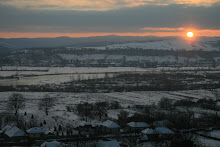
We were on the fourth day of walking and every day I had been expecting to get a lift from a horse and cart. Unfortunately, it just happened that we didn't find one going in the right direction. On this morning we were walking along the Sas valley through Botiza village to end at its centre and then start our walk over the hill. It is a 3 km walk along the road and I said again "This is the time I wish a horse and cart would appear". I had said the same when we were walking between Budesti and Sarbi and again between Hoteni and Breb and between Poienile Izei and Botiza.
So, I came to the conclusion that there are fewer horse and carts than before, because in all these days we hadn't managed to hitch a ride. Simon replied "You might be right, but mathematically we haven't got enough evidence to show that. And also, just because we have spent so long waiting for a horse and cart to come along already doesn't make it more likely that we will catch one today"
Ha! After a few minutes a man leading a horse and cart came out of his yard and started off in our direction. I called and asked him if he would wait for us. He replied that he was more than happy to give us a ride. He had his wife by his side and they were both going to the fields for hay.
In the centre of the village we stopped for two more women hitchhiking to Sieu. I am sure they were waiting for a car, but hey, a wagon will do! We had such a good laugh with the four of us squashed in the back of the cart!
So, I came to the conclusion that there are fewer horse and carts than before, because in all these days we hadn't managed to hitch a ride. Simon replied "You might be right, but mathematically we haven't got enough evidence to show that. And also, just because we have spent so long waiting for a horse and cart to come along already doesn't make it more likely that we will catch one today"
Ha! After a few minutes a man leading a horse and cart came out of his yard and started off in our direction. I called and asked him if he would wait for us. He replied that he was more than happy to give us a ride. He had his wife by his side and they were both going to the fields for hay.
In the centre of the village we stopped for two more women hitchhiking to Sieu. I am sure they were waiting for a car, but hey, a wagon will do! We had such a good laugh with the four of us squashed in the back of the cart!






